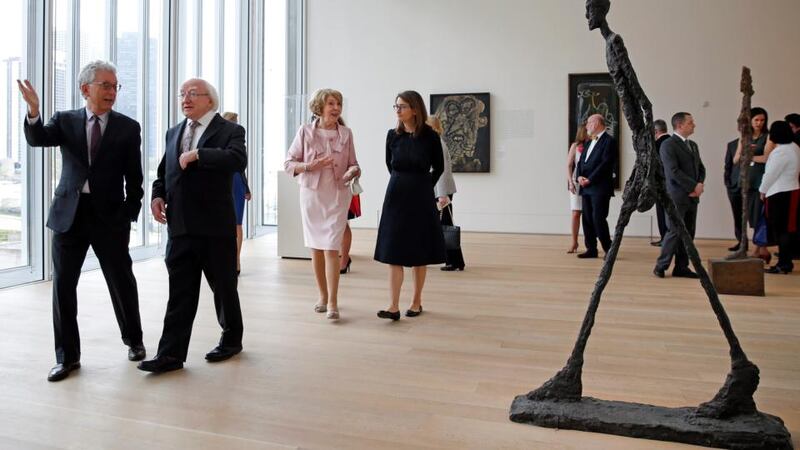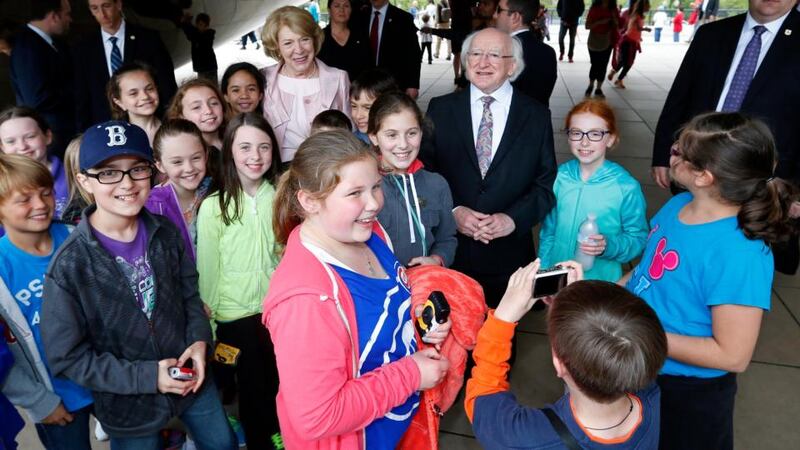Migrants, the rich tapestry called the Irish diaspora, enables the country to play a key part in global affairs, President Michael D Higgins said in an address rounding off a five day visit to the United States.
The President, speaking a lunch in Chicago hosted by the University of Notre Dames Irish institute, focused on the role of the country’s scholars, writers, artists and others in creative fields.
“Our writers, artists, directors, actors and performers have retained in their craft much that is fundamental to our essential Irishness while bringing home novel ideas, influences and know how,” the President said.


In his address, at the event at the Chicago Club hosted by the Keough-Naughton Institute for Irish Affairs, the President said the impact of the Irish emigrant experience on the culture at home has been “creative, as it has been profound and lasting.”
On the global theme details emerged during the President's visit of a major three part documentary series on the 1916 rising, partly funded by the Irish government. The series is being developed by the Irish institute and will be broadcast on RTÉ, BBC and the US public broadcaster, PBS. It will look at the rising and its impact globally, particularly in the US and Britain, said Bob Schmuhl, of Notre Dame's College of Arts and Letters.
The rebellion was largely funded by money raised in the US while at the highest political level Washington had to work out if there was another front opening up in the war, Mr Schmuhl said.
President Higgins said he was delighted to learn the project is being developed using a Single Purpose Vehicle instrument, which he established as Minister for Arts, Culture and the Gaeltacht. The Irish government is providing $1m in matching funds.
The President visited the city’s Art Institute, which houses one of the most extensive collections of art in the US, with paintings by Van Gogh, Monet and Picasso. He stopped for a while before one painting, an abstract piece by Vasily Kandinsky entitled ‘Painting with Troika’.
It will be the venue for a major exhibition of Irish art, artefacts and furniture, dating from 1690 to 1840 and which opens on St Patrick’s Day next year. The culmination of five years of work, all the more than 300 items on display were sourced from public and private collections in the US.
Many of them found their way to north America following the shuttering of the Big Houses in the 1920s, after independence, said Christopher Monkhouse, the organiser of the exhibition.
For Mr Monkhouse, the head of the Institute’s Department of European Decorative Arts, this exhibition has been more than 40 years in the making. “This is the culmination of my career. I have been thinking about this ever since going to Ireland in the 1960s,” said Mr Monkhouse. It was then he met the late Desmond Fitzgerald, the Knight of Glynn, an expert on Irish art who even near death still talked about sourcing items for just such an exhibition.
President Higgins went walkabout after his visit to the Art Institute, visiting Millennium Park and its signature sculpture, officially known as Cloud Gate, known to everybody as The Bean. His appearance caused a stir among the tourists and schoolchildren. There were shouts: “The President is here.”
Surrounded, the President posed for pictures with children underneath the sculpture, where a person can gaze up and see their reflection, again and again and again.
President Higgins’ final public engagement of his trip was a visit to the Misericordia Heart of Mercy residential home for physically and developmentally disabled children and adults. He was due to take a trip, under darkening skies and threatened rain, on the river boat architectural tour.
Tonight, he and his wife Sabrina, planned to visit the city’s famed Steppenwolf Theater for the first night of The Way West, a contemporary musical set in California.
The President returns home tomorrow following the five day trip to Chicago and Indiana.









